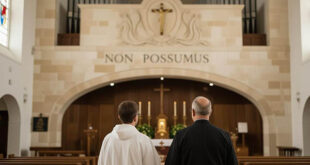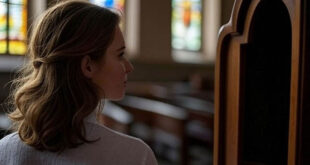A theological, spiritual, and pastoral journey through one of the most beautiful dogmas of Catholicism
Introduction: Tradition or invention?
The Assumption of the Virgin Mary into heaven, body and soul, celebrated every August 15th, is one of the most beloved — and at the same time, most questioned — dogmas of Catholicism. For many Catholics, it is a mystery filled with hope and beauty; for others, especially from certain Protestant currents or even among poorly catechized Catholics, it is seen as a late invention with no basis in Sacred Scripture. So, does it have biblical and theological foundations? Why was it proclaimed as a dogma of faith? And what does it mean, concretely, for us today?
Let us dive into this truth of faith with eyes enlightened by reason, Scripture, Tradition, and theology, and with hearts ready to discover the beauty of the glorified motherhood of Mary.
1. What does the Church teach about the Assumption?
On November 1, 1950, Pope Pius XII solemnly proclaimed the dogma of the Assumption in the apostolic constitution Munificentissimus Deus:
“…the Immaculate Mother of God, the ever Virgin Mary, having completed the course of her earthly life, was assumed body and soul into the glory of heaven.”
This dogma does not define how or when the Assumption occurred (though tradition holds it happened in either Jerusalem or Ephesus). The central point is that Mary did not undergo the corruption of the tomb, but was glorified by God at the end of her life, in both body and soul, as a foretaste of what awaits all the redeemed.
2. Is the Assumption biblically based?
Although the word “Assumption” does not appear literally in the Bible (just as “Trinity” or “Incarnation” do not either), the doctrine is deeply rooted in Revelation, both in Scripture and in Tradition.
a. Hints in the Old Testament
Even in the Old Testament, we find precedents that prepare this truth:
- Enoch was “taken” by God (see Gen 5:24).
- Elijah was taken up to heaven “in a whirlwind” with a chariot of fire (see 2 Kings 2:11).
These figures prefigured the possibility of a human being glorified without experiencing bodily corruption. And if this was possible for them, how much more so for the Mother of the Savior, full of grace and free from original sin?
b. Revelation 12: The Woman clothed with the sun
The most cited passage by Marian theology is Revelation 12:1:
“A great sign appeared in the sky: a woman clothed with the sun, with the moon under her feet and a crown of twelve stars on her head.”
While some interpret this as a symbol of God’s people or the Church, the Catholic Tradition has also seen in this woman an image of Mary glorified in heaven. She appears in heaven, as queen, mother of the Messiah, and victorious over the Dragon (Satan). It is a clear image of exaltation, victory, and glory.
c. St. Paul: the glorification of the body
In 1 Corinthians 15, the Apostle Paul teaches that at the end of time, the bodies of the faithful will be glorified:
“What is sown is perishable, what is raised is imperishable […] For this perishable body must put on the imperishable” (1 Cor 15:42–53).
Mary anticipates what the Church hopes for at the end of time: she already participates in the future glory that we hope to attain in the resurrection.
3. Foundation in Apostolic Tradition
From the earliest centuries, Christians have believed that Mary’s body did not undergo corruption. While the Bible is silent on the moment of her death, the Church Fathers, ancient liturgies, and patristic homilies point to the consistent faith of the Christian people.
- St. John Damascene (8th century), in his homily on the Dormition, said:
“It was necessary that she who had carried the Creator of life in her womb should herself be carried to life by Him.”
- Gregory of Tours (6th century) recorded the belief that “her body was taken into heaven” and not found in the tomb.
Moreover, there is no early Christian tradition of venerating bodily relics of the Virgin, unlike so many martyrs and saints whose remains were honored from the earliest days.
4. Why is this dogma important?
The Assumption is not just an exaltation of Mary, but a promise for all redeemed humanity. She is the model of the Church and the firstfruit of our future glorification.
a. Mary as the “Ark of the New Covenant”
In the Old Testament, the Ark contained the Word (the tablets of the Law) and was treated with deep reverence. In Mary, the Word made flesh dwelled. In Rev 11:19 — just before the vision of the woman clothed with the sun — we read:
“Then God’s temple in heaven was opened, and the ark of his covenant was seen in his temple.”
The Fathers saw here a clear reference to Mary, the living Ark, now glorified in heaven.
b. The Assumption as an eschatological sign of hope
The Catechism of the Catholic Church puts it this way:
“The Assumption of the Blessed Virgin is a singular participation in her Son’s Resurrection and an anticipation of the resurrection of other Christians” (CCC §966).
Mary already lives what we hope for. Therefore, her Assumption is a sign of hope, especially in a world wounded by despair, pain, and death.
5. Practical applications and spiritual guidance
What does all this have to do with our daily lives? Much more than it seems.
a. Our vocation to glory
In a world that exalts immediacy, carnality, and materialism, the Assumption reminds us that we are called to eternity, to full union with God, in soul and body. We are temples of the Holy Spirit, and our bodies are not destined for final corruption, but for glorious resurrection.
“The body is not for immorality, but for the Lord, and the Lord is for the body” (1 Cor 6:13).
The Assumption of Mary invites us to live with dignity, purity, and eschatological hope.
b. Consolation in suffering
In times of pain, loss, or fear of death, the Assumed Mary is a glorious mother who intercedes for us, watches over us from heaven, and assures us that the end of the story is eternal life.
c. A school of humility and trust
Mary was not glorified by her own merits, but by God’s grace. Her life was one of service, silence, and fidelity. Her greatness was her littleness:
“The Lord has looked upon the humility of his servant…” (Luke 1:48).
To imitate Mary in her faith, her surrender, and her humility is the surest path to our own future glorification.
Conclusion: Invention or treasure?
The Assumption is not an invention, but a truth revealed progressively by the Holy Spirit over the centuries, recognized by the Magisterium, rooted in Tradition, and consistent with Scripture. It is a dogma that looks to heaven, but with feet on the ground, because it helps us live with more hope, purity, and a sense of transcendence.
Christianity is not the religion of death, but of the Life that conquers death. And in Mary, the first of the redeemed, we are given a living image of what awaits us if we follow Christ faithfully.
Final Prayer
Holy Mary, assumed into heaven, our Mother,
you who were raised body and soul into glory,
teach us to live with our eyes fixed on heaven
and our hearts full of charity.
Obtain for us the grace to live purely,
to suffer with hope,
and to die with our trust placed in your Son.
Amen.






